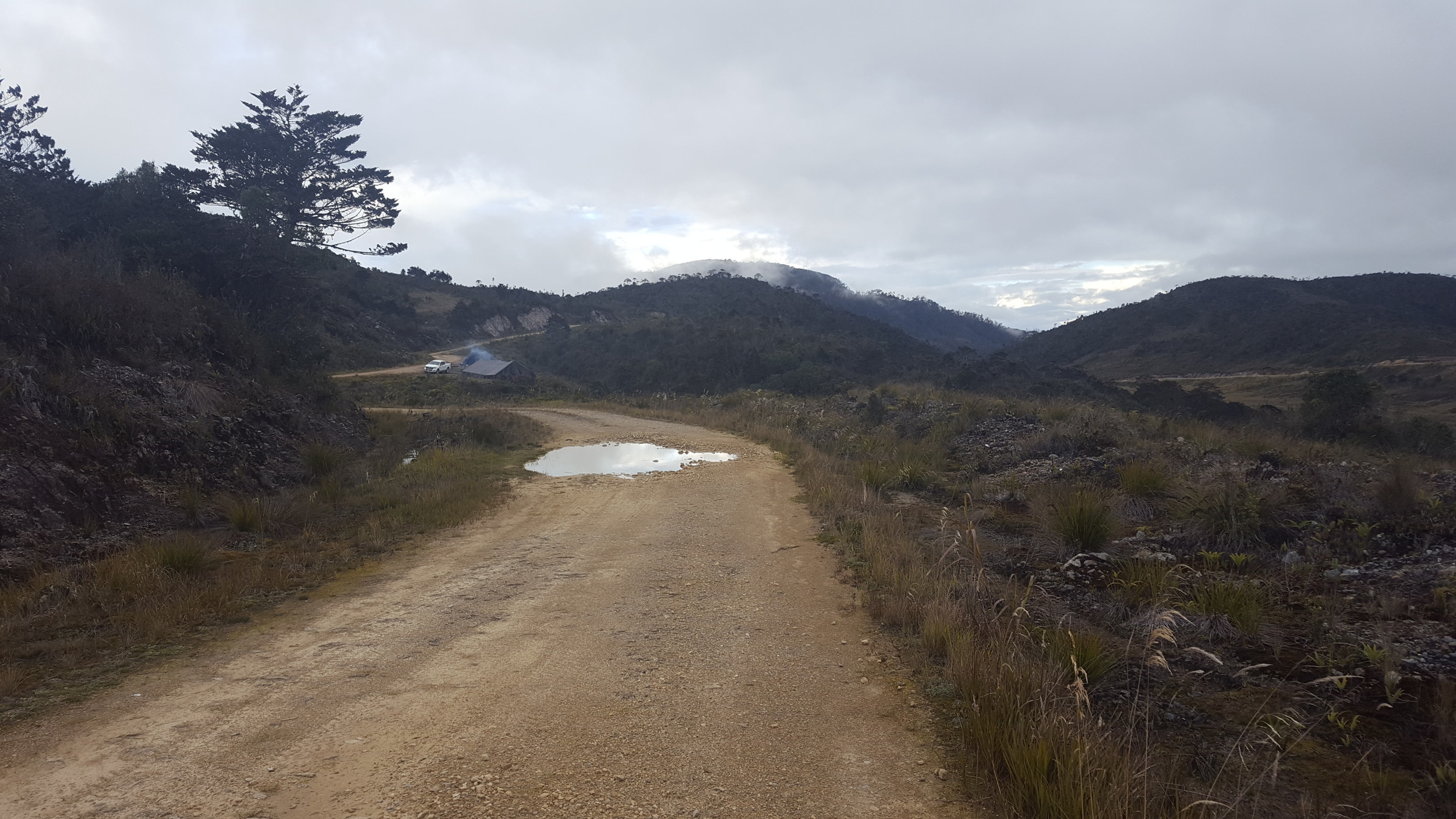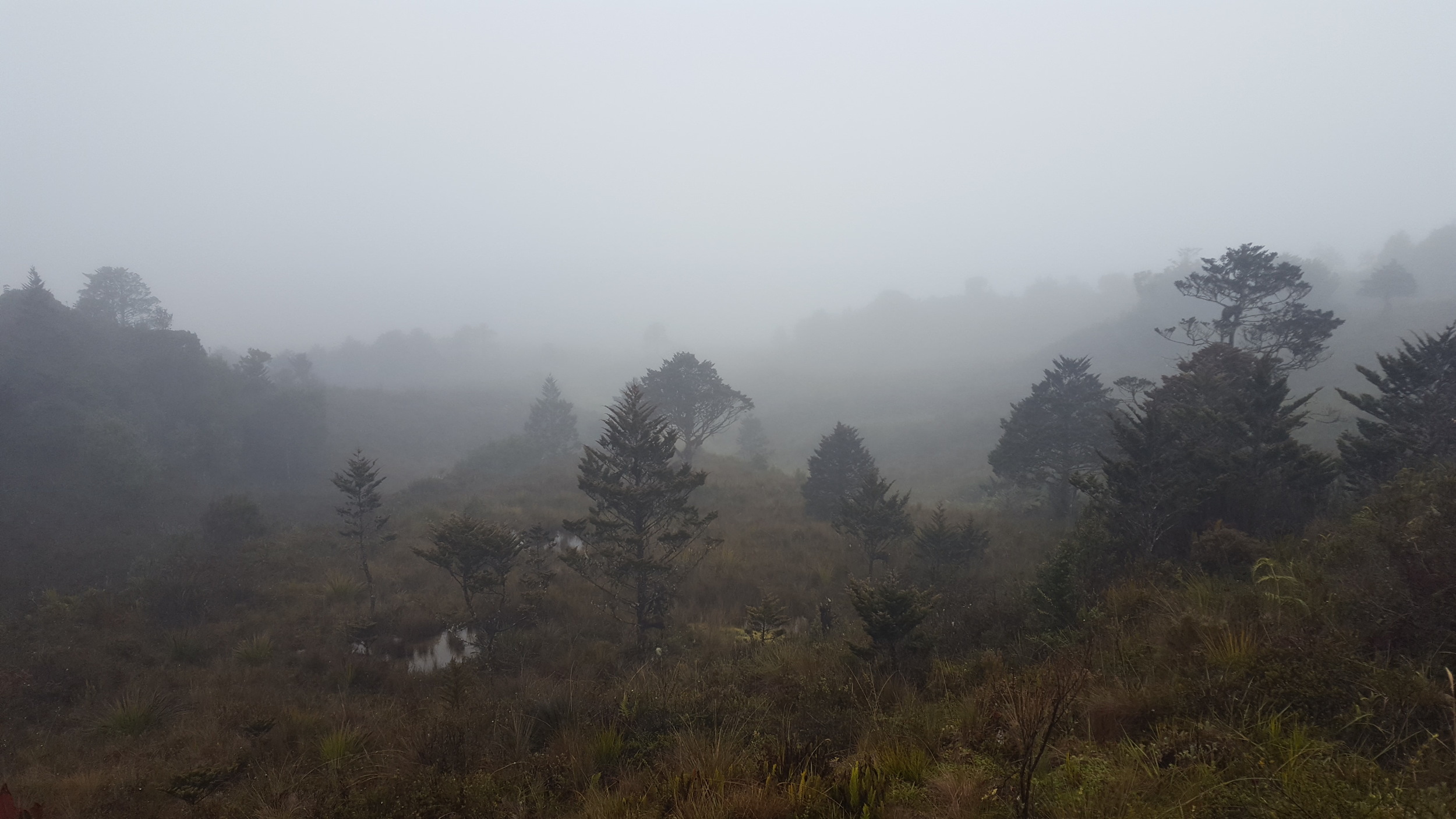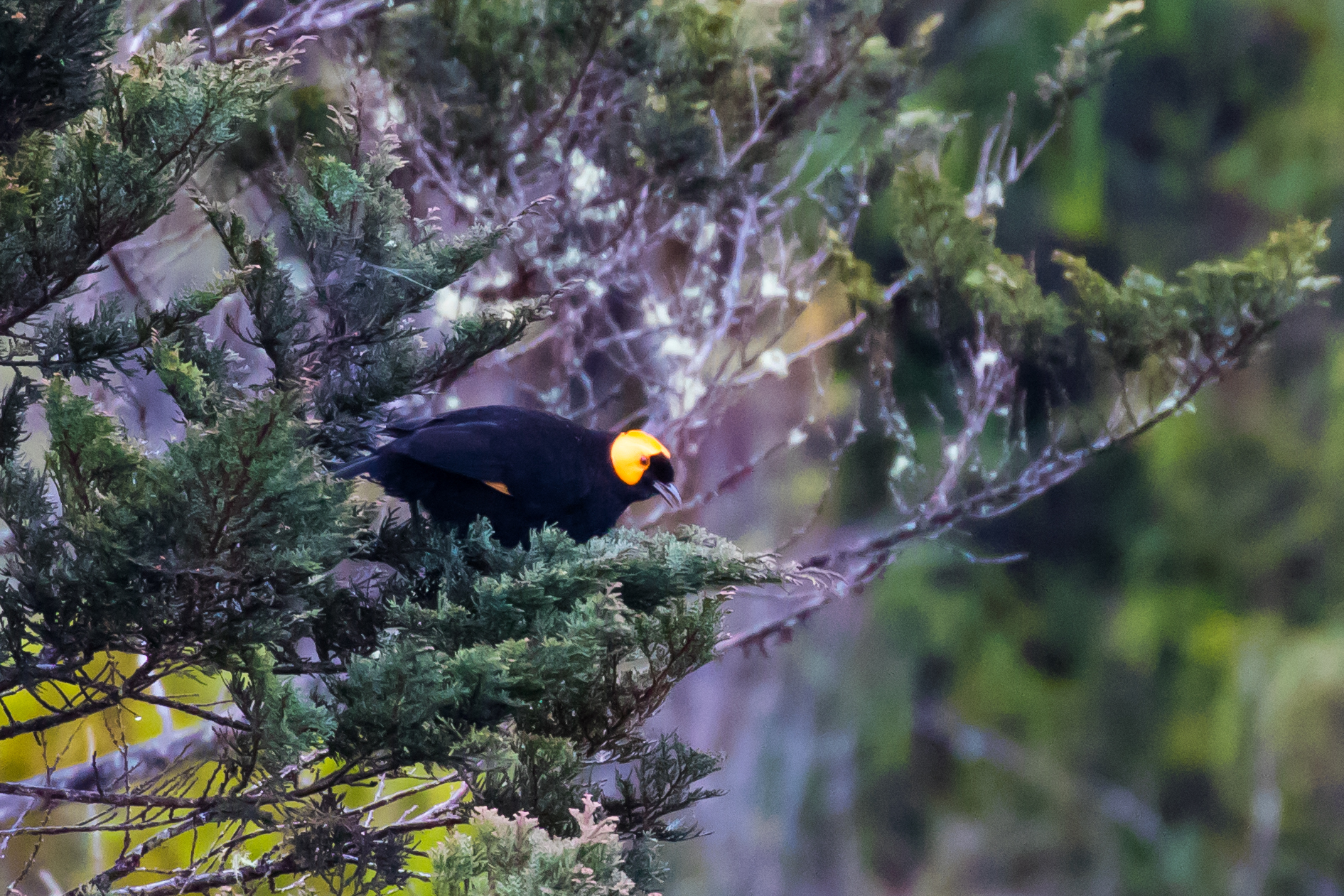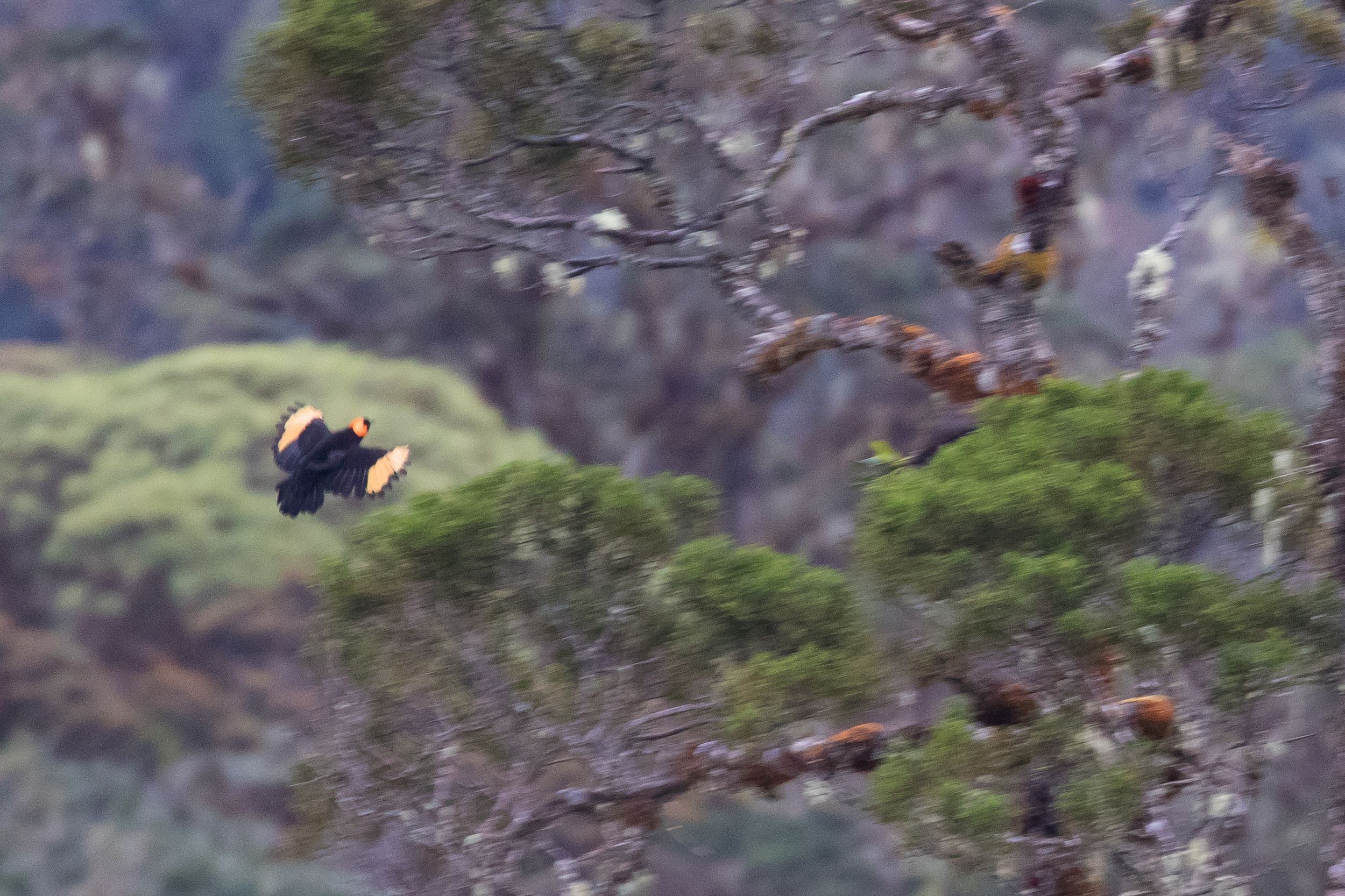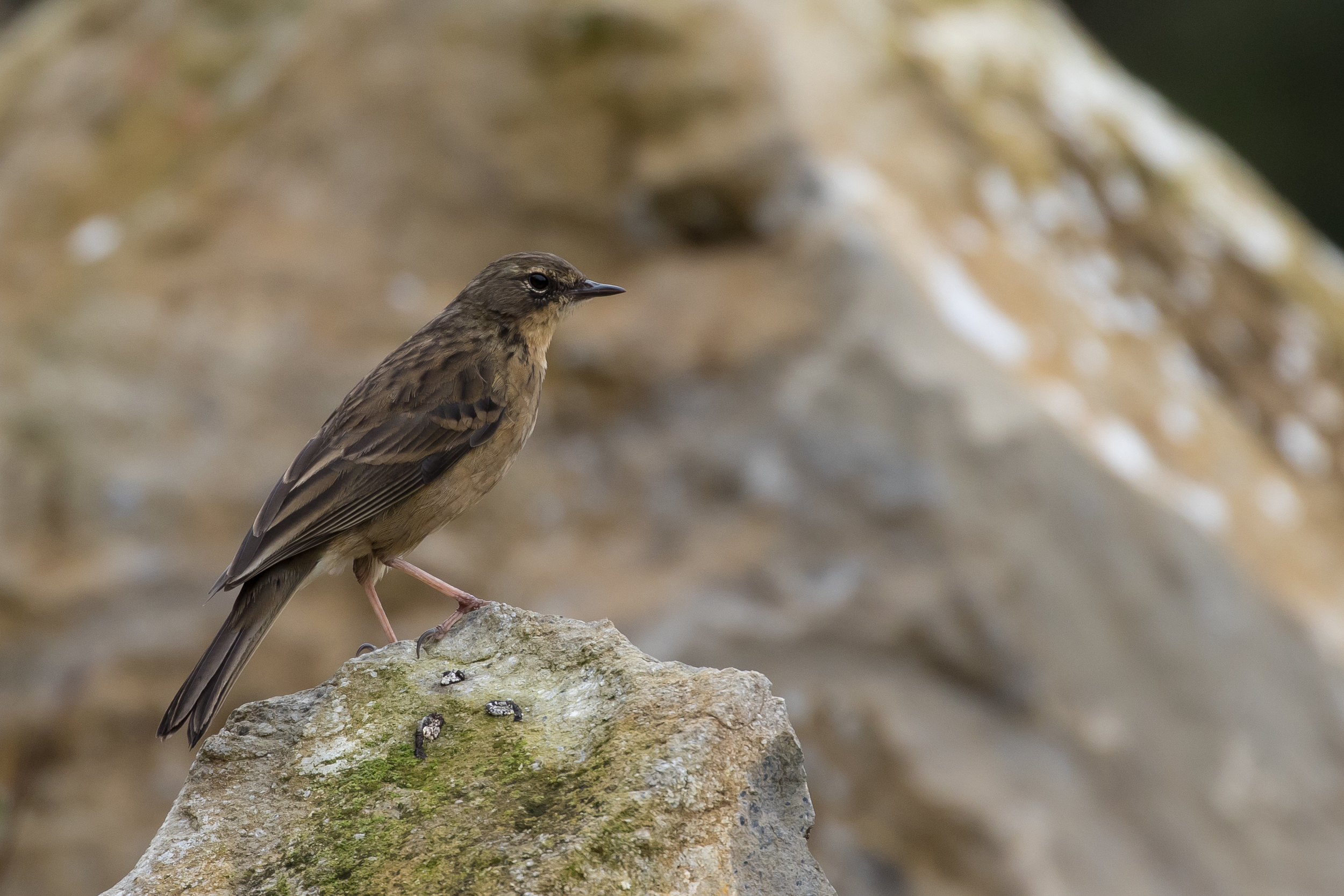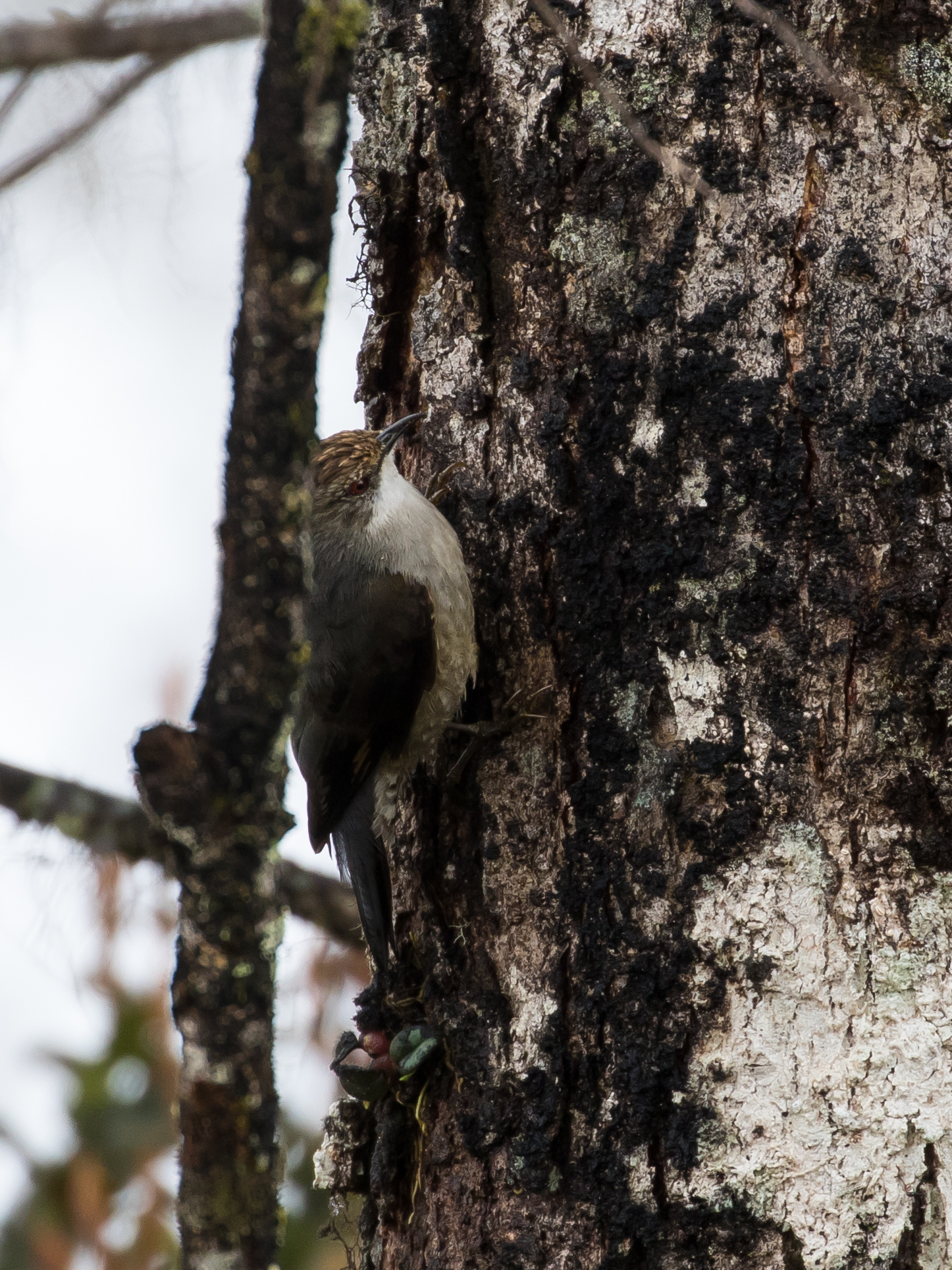On July 11th, 2018, I started an amazing, bucket-list trip to West Papua, a place filled with arguably the most incredible birdlife on the planet. Long-time birding buddy Steve Young and I have been talking about such a trip for along time, and I started thinking even more seriously about it when I came to Australia a few years ago. Which is weird, because the geographical proximity doesn’t actually work out at simpler logistics or even much less flying time. It may seem close, but West Papua is actually a bugger to get to from anywhere!
If you have a great deal of time and supreme birding skill, perhaps it’s possible to “do” West Papua independently (see, eg Ross and Melissa Gallardy’s blog). But for mere mortals like me, there are really only 2 options when it comes birding in West Papua. One is to book with a bird tour company. But this is expensive, means travelling with a group of other punters who may or may not be good companions, and fixes the itinerary — a typical trip is either a 4 week extravaganza, or a 2 week highlights trip. The shorter trip appeals more to me because I doubt I can justify a month away from home or work, but any such trip would miss key sites. The second option is to go semi-independent, with a group mates on a self-designed itinerary. This is what we choose in the end: we book a private trip with Shita Prativi, who is the best in the business when it comes to local logistics in West Papua. Even this option is not cheap by 3rd world standards, but the trip with a small group for 3 weeks still comes in cheaper than a 12-day Birdquest trip of 8 punters, for instance. Of course we will not have the benefit of an experienced world-birder like Mark Van Beirs or Rob Hutchinson leading and finding birds for us. But personally I am excited by the extra challenge. True, we might miss some stuff, but I enjoy the extra preparation required (downloading mp3s from xeno-canto, making sure I have all the kit for playback, sorting out torch for night-birding, etc) and I look forward to the extra satisfaction of finding more birds for ourselves.
Day 0, 11/7/18, “On my way”
My trip starts in Adelaide with a flight to Perth where I do a couple of days work preparing for a conference I am running there in December. This is convenient because Perth, unlike Adelaide, has a direct flight to Jakarta. I leave Perth on 11th and arrive in Jakarta late evening after a 5 hour flight. Now I have a wait of nearly 24 hours. Though I have toyed with the idea of birding Jakarta — and there are some goodies to be had in a day trip — I am unable to organise a guide for the day, so instead I sit in an airport hotel getting some work done as my birding companions wing their way from London Heathrow. Steve Young is the reason I became a birder and we have birded together abroad since our first long-weekend trip to Spain in 1999, nearly 20 years ago now (scary when I put it like l that). The third member of the team is Jon Porter, a Welsh school-teacher whom I first met in Scotland 16 years ago when Steve and I did the highlands in our “Grouse and Raptors” trip in 2002 (see Steve’s report). In fact that was also the last time I’d seen Jon!

After meeting the UK 2/3rds of the team in Jakarta airport soon after their flight touches down, we explore the domestic portion of the terminal hoping to kill the next few hours in a bar. But to our horror we discover that the airport is dry. We will not get a beer for nearly a week. Eek!
Day 1, 12/7/18, “Meet the parents”
Our overnight flight from Jakarta arrives as scheduled at 6am into Sentani, a satellite town to the main city Jayapura, West Papua’s capital, situated at the north-eastern extremity of West Papua. The New Guinea lowlands are hot and sticky — it is already 30 degrees!
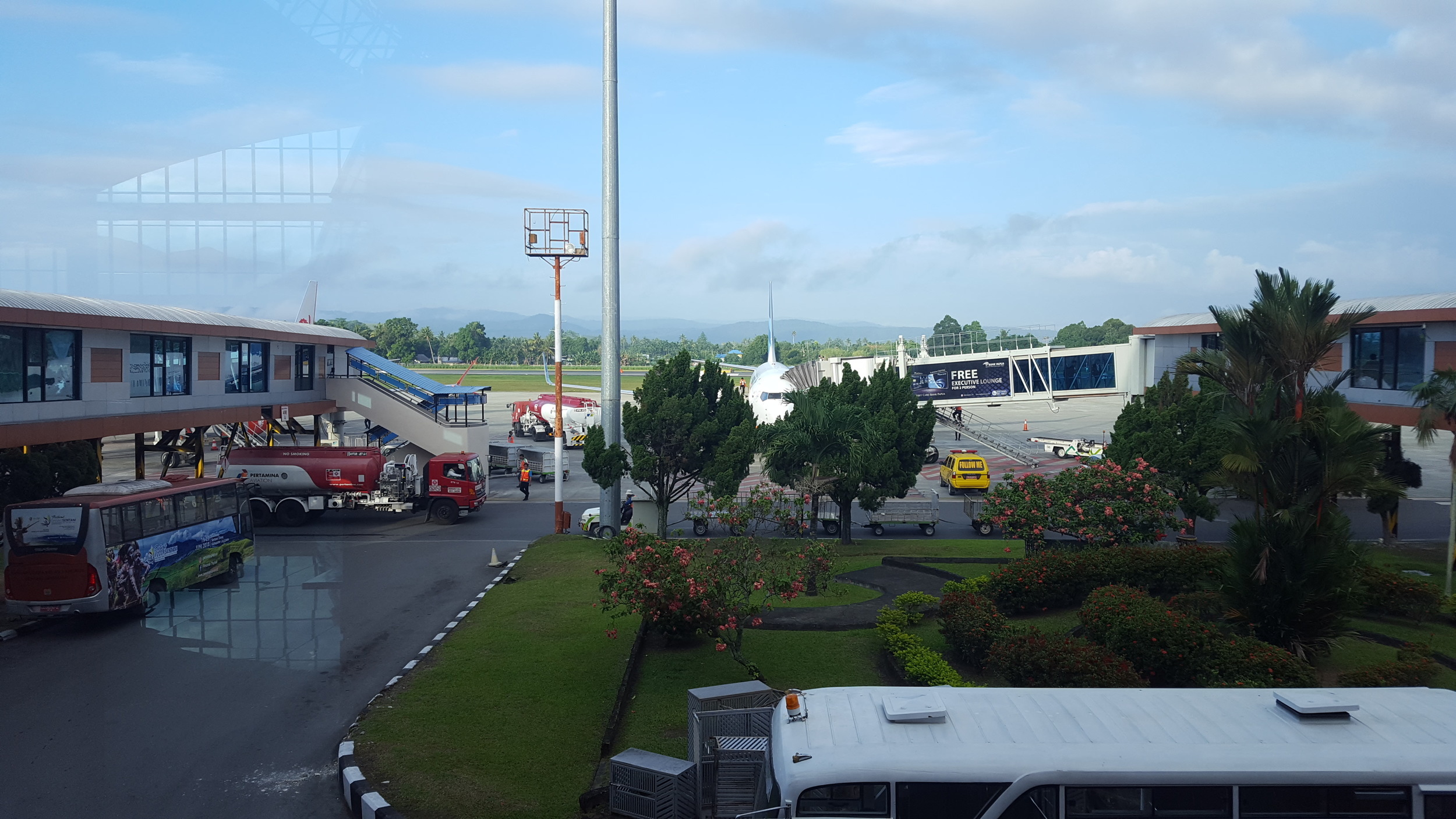
We have been in the air as England have been playing Croatia in the World Cup semi, but the extra time loss for England is not one we are excited to discover on arrival. We meet our local contact and give him some of our gear for safe-keeping (the baggage allowance for our next flight is a meagre 15kg) then board for another 50 minute flight to Wamena in the Baliem Valley. This valley in the central highlands of West Papua, also known as the “Grand Valley”, was incredibly only “discovered” by westerners in the 1930s.
In Wamena we meet up for the first time with the fantastic duo who will be our guides, keep us fed and out of trouble and generally look after us for the next 3 weeks, Shita Prativi and Benny Mambrasr. Shita has been organising trips for birding in West Papua for 14 years and no one knows how to sort out the logistics of this tricky country better than her. She’s done it for Birdquest, Birdtour Asia, Rockjumper and even Jared Diamond and Tim Laman. Her side-kick Benny is a converted hunter from Waigeo, still learning his trade as a birder, but with an amazing hunter’s eye and instinct for finding the “prey”.
We load up the Hilux and drive up to our camp at 3500m overlooking Lake Habema. Of course we bird en route, finding a couple of extremely range-restricted birds in the process, Baliem Whistler and Black-breasted Mannikin in grasslands and gardens outside Wamena.



A key target before we get too high is Superb Bird-of-Paradise, a stunner with an amazing blue breast-band that Steve and I had heard regularly in the Huon Peninsula a decade ago but which back then steadfastly refused to show itself. Today we find one at Shita’s regular site outside Wamena but are unable to grab any kind of image on our CCDs.
More cooperative are the stunning (though common) Western Crested Berrypecker,
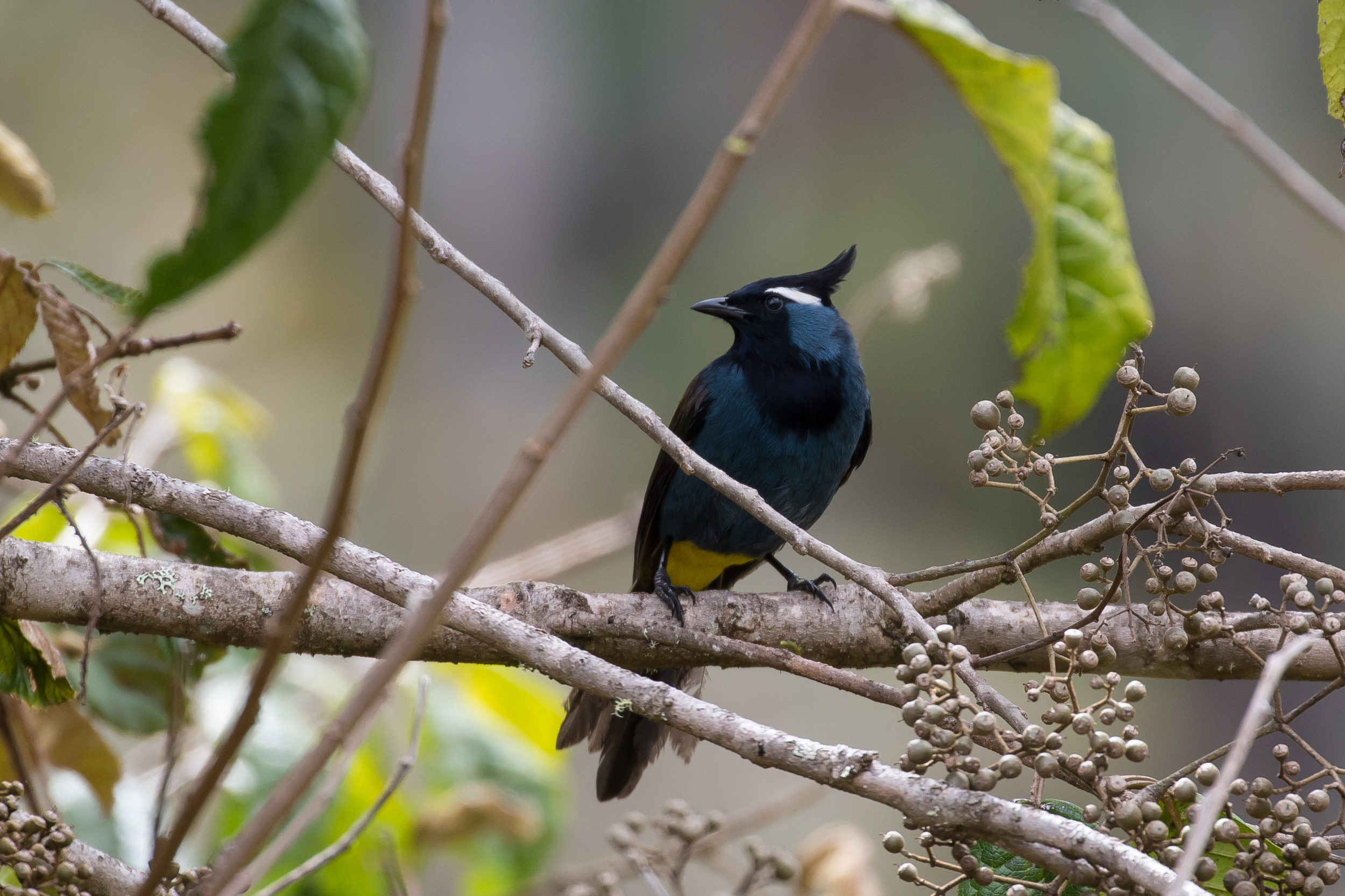
a couple of high altitude honeyeaters, Common Smoky Honeyeater and Belford’s Melidectes (big, bold, loud common and conspicuous) and a couple of nice robins, Sub-alpine Robin and White-winged Robin.




We find another range-restricted goody, Snow Mountain Tiger Parrot, feeding quietly by the roadside shortly before we arrive at the makeshift camp that will be our base for the next 4 nights.
The camp, overlooking Lake Habema, has been constructed by locals the day before and comprises a large wooden frame lashed together and covered in tarpaulins. Out the back is our “long drop” toilet. Jon goes to inspect and returns with the news that it would be better termed a short-drop and he fears he may have filled it up already.
It will be cold – very cold – overnight, so we rug up. Steve and Jon, suffering from jet-lag, have a very restless night barely managing a wink of sleep. Here at Lake Habema I am almost directly north of Adelaide – a direct flight would take about 5 hours – so although it has taken me more than 14 hours on 4 separate flights to get here, at least my body is adapted to the timezone, if not the altitude. I manage a few hours of restless sleep until woken by the locals who, under the influence of some smuggled in moonshine, have a loud and very serious argument at 3am. The next morning we find out that the insults have escalated and machetes were drawn.
Day 2, 13/7/18, Our first full day in West Papua
As will become the norm over the next 3 weeks, we rise pre-dawn at 5am (in fact this will be a late rise). We are expecting a minimalist breakfast but incredibly the locals, supplied by Shita’s planning and shopping (and of course our wallets), have used their simple fire in the other tent to prepare a full breakfast that includes omelettes and pancakes, which we wash down with hot, sweet, 3-in-1 “coffee”.
It is still dark when we arrive at the start of the famous Ibele Trail. As recently as 10 years ago this whole area was pristine montane forest, and we imagine dripping with birds of paradise, but now there has been extensive logging — the worst over the last 6 years — and we are saddened at times to hear chainsaws over the next few days. The Ibele Trail is just about the only spot that retains decent forest and we will spend the next 3-4 days walking down and back up this steep, muddy trail in the mossy cloud forest that leads to the isolated and traditional village of Ibele, several km below. We are all grateful for the wellies we have brought and barely change out of them for the next 4 days.
We dip on any night/dawn birds but once it is light we spend some time at the top of the trail scanning below us. Immediately we are rewarded as a pair of stonking MacGregor’s Honeyeaters glide across and feed in the tops of lichen-moss covered trees. Formerly classified as a Bird of Paradise, we agree that irrespective of the DNA it looks like no other honeyeater and really deserves still to be a BoP. Massive rounded wings make a rushing sound as the flap that we can hear across the valley, and its outrageous golden-orange wattles stand out like beacons. A cracking start.
We trudge down the trail, descending maybe 500m over 1-2km where we spend much of the next 3 hours hunting out some superb skulkers of the moss forest. First up, Benny hears a Lesser Melampitta. As we try to coax it into view a brown bird pops up next to a tree trunk and Steve is immediately on the case – Lesser Ground Robin. The Melampitta makes us work harder but we all snag cracking views of this black, velvety bird. Though our views are outstanding, they are brief and Steve and I have both opted for viewing rather than photography. Next up Benny hears a Greater Ground Robin.
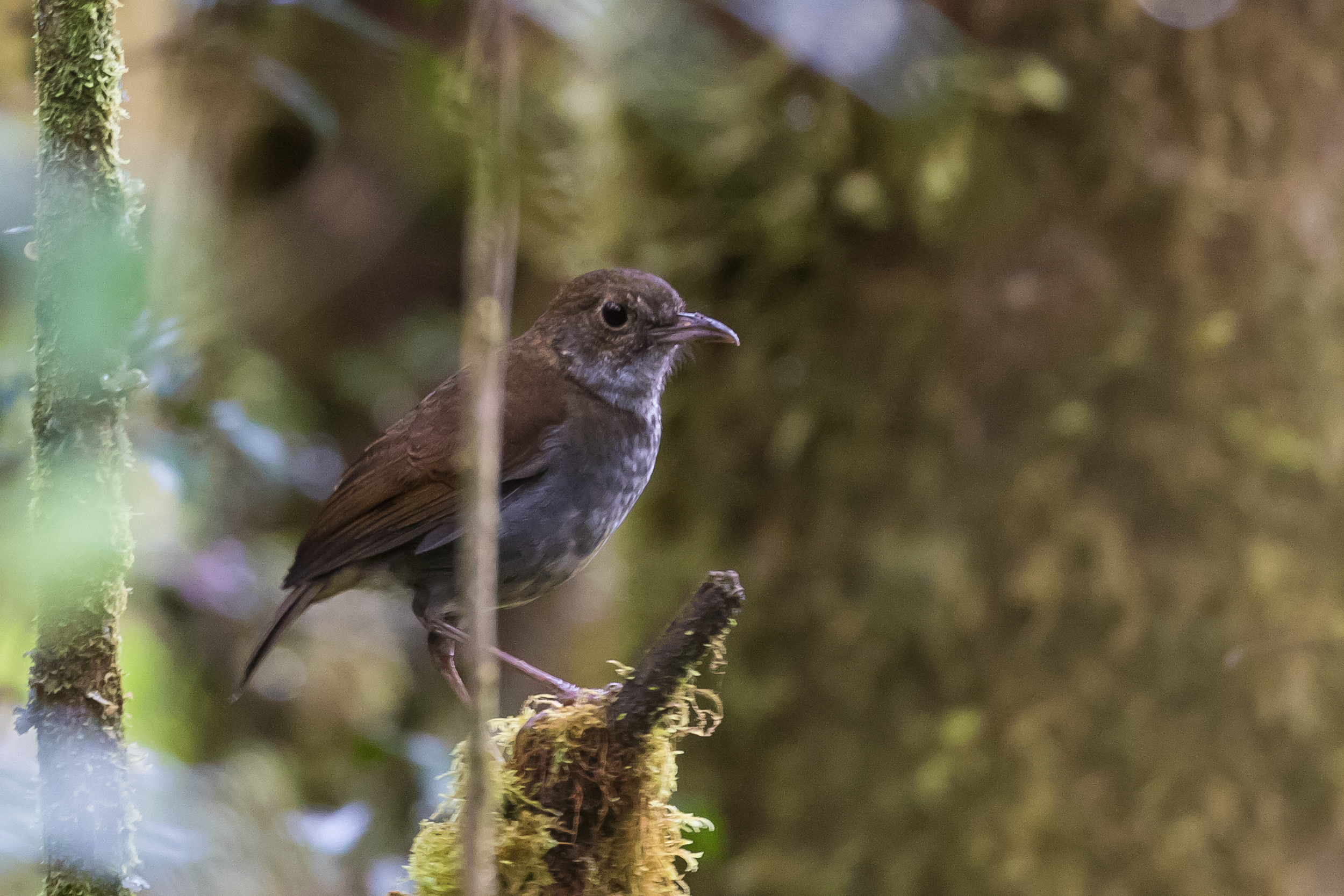
We are up for the challenge and spend the next 30mins tracking down the stonker which eventually yields excellent views to all. To complete a set of skulking stonkers, a pair of Papuan Logrunners responds to our playback, eventually yielding brief, but at least tickable views for me. Meantime Steve’s sharper reflexes and better field-craft have even produced a record shot.
In one of the more open areas, while we continue to try for the Logrunners a largish bird with white tail feather glides across the clearing distantly. I have enough on it to be able to tick off Splendid Astrapia, the key Bird of Paradise here in the Snow Mountains. It lands and Jon and I are straight onto it. It is dark but through my gorgeous 10×42 Swarovskis I can see the rich greens and odd facial pattern of the adult male. It’s too distant for me even to bother going for the camera and even worse, Steve can’t get on it before it drops out of sight.
Late morning we are starting to turn our attention to our rumbling tummies and trudge back up the trail. We reach the vehicle just as it starts to rain in earnest and when we get back to camp Shita (who has stayed to sort out last night’s fracas and make sure it doesn’t happen again) is relieved to hear we’ve had such an outstanding morning because a few km away at the camp it has been pissing down since dawn.
After an early lunch we rest a bit. Steve and Jon, weary from consecutive overnight flights and a sleepless machete-laden first night at 3500m a.s.l., doze longer than me, and I stroll along the road near the camp. Numerous scrubby flowering bushes are a magnet for honeyeaters and I grab images of Orange-cheeked Honeyeater, Sooty Honeyeater and Short-bearded Melidectes, all high altitude specialists – though as I write this I discover that I have somehow unaccountably lost all my images from this afternoon. Arrrghhh!
With sleeping beauties awake again by mid/late afternoon, we decide to drive along the road beyond the camp where Shita and Benny often have Astrapias. We are blighted by the weather though. Even when it is not raining the forest is in deep mist and visibility wretched. It gets dark quickly and early, but we do have one more treat in store. As we drive back to camp there is a thumping on the roof. Standing in the ute tray, Benny has seen a Snow Mountain Quail. We pile out in time to see it flush off down the valley. A few hundred metres on and there’s that banging again. This time we see 2 quail shuffle across the road and disappear down the slope.

So we end the day with a short but not-too-shabby list of birds: MacGregor’s Honeyeater, Splendid Astrapia, both Greater and Lesser Ground Robin, Lesser Melampitta, Papuan Logrunner, Snow Mountain Quail and a bunch of nice honeyeaters. The trip is off to a flier.
Day 3, 14/7/18, “A wader and a duck”
We make an even earlier start to try to connect with a nightjar or woodcock back at the top of the Ibele Trail. We hear nothing until it is already getting light, when we hear a New Guinea Woodcock, one of our most wanted. But it is deep in a thicket, not making its flight call but instead making grunting noise that we learn from Shita it makes as it roosts. At our behest, a couple of the locals go in to search – either they will find it on the deck for stunning views, or worst case, flush it. As it turns out we have miscalculated the worst case. The locals fail on both counts, but in a desperate measure we head in ourselves. It promptly flushes low around the valley and some distance away. In the dense thicket we see nothing and are alerted by the locals and guides who tell us it has flown. Bugger! Sigh! If you want a job doing…
We put the dip behind us. The weather looks better today, and we begin birding the Ibele Trail with expectations that it might be even better today than yesterday. We are again mistaken: it is much quieter and harder work. We find Lesser Melampitta again, and I claw back Rufous-naped Bellbird which showed well yesterday but I missed. We then spend a long time at the small clearing with a view up to fruiting trees where we’d seen the adult male Astrapia the previous day. We finding a female/immature, but no male. The Logrunners do not respond to playback. And then have a series of near misses and if-onlys. Shita sees a female Brown Sicklebill but it stays put for only a few seconds and none of us gets onto it. We think that the strange rasping we hear from the top of a fruiting tree might be the rare and elusive Archbold’s Bowerbird, and at one point a large, all-dark, long-tailed bird bombs out from the vicinity but none of us gets enough on it to be sure. We see a similar collection of the commoner birds from yesterday: Orange-billed Lorikeet, Plum-face Lorikeet, Belford’s Melidectes and add Brehm’s Tiger Parrot but at around 10.30 the weather has deteriorated and we decide we need a change of scene.
After an early lunch we decide on a trip down to the lake. We drive beyond the camp to a point near the eastern edge of the lake. En route we screech to a halt as a small flock of Mannikins flies up from the roadside. We all pile out of the Hilux and track down a group of 4-5 of the extremely restricted Snow Mountain (Western Alpine) Mannikin.

We then descend yet another steep trail towards Lake Habema, though this one is mercifully less muddy. Black-throated Honeyeater is new, and once we get to a decent viewing point we set up scopes and grill every bird we can see on the water.
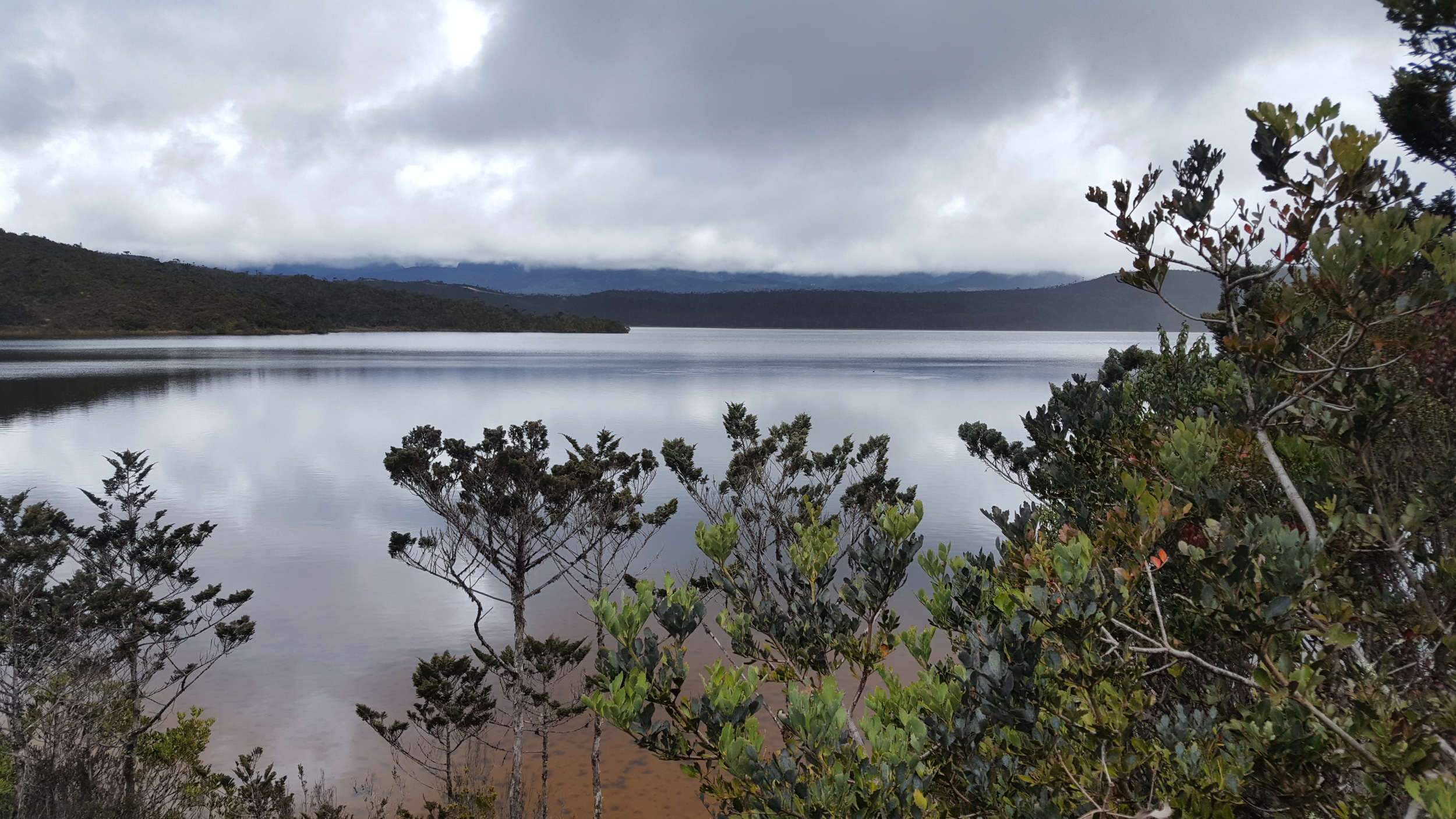
Disappointingly the first dozen birds are Eurasian Coots! But a few minutes later we lock onto a pair that seem just a little different and sure enough we have found Salvadori’s Teal, and intricately patterned torrent duck. Jon is especially gratified to connect, having dipped after several extended vigils on mountains streams in PNG in 2003. Scratching a 15 year itch is very satisfying. We carry on down to the water’s edge for closer views of the Teal and also get better views of Orange-cheeked Honeyeater and Black-throated Honeyeater on the way as well as enjoying the change of scene from the Ibele Trail. A Swamp Harrier cruises the edge of the lake, one of the few raptors we have seen.





We are back at the camp in time to drive back to the Ibele Trail and sunset finds us staking out the clear area at the top of the trail yet again. A couple of silhouetted lorikeets are very distinctive from their ribbon tails: Stella’s Lorikeet.
Benny stays up near the top of the trail but — probably too impatient — Steve, Jon and I wander down closer to where we think the Woodcock may have landed this morning. An Astrapia calls but we can’t locate it and it doesn’t respond to my playback. The temperature drops as the sun departs and, cold and disheartened by this mornings near miss, we are still hearing nothing. We decide to give it until 6.30. In need of some warmth and food we are about to walk up and tell Benny we are going to knock it on the head, when at 6.30 on the dot we hear the distinctive and quite unbirdlike display flight call of New Guinea Woodcock. We race uphill just in time for Benny to tell us it has just flown over his head. Double-bugger!
Fortunately it comes for a return journey and we have fantastic flight views of the rare endemic wader. As we walk back to the car victorious, mood flipped completely, we flush a Nightjar, which must be Archbold’s Nightjar.
So we end Day 3 with very few new species, but we have added to the list of high altitude specials, including Archbold’s Nightjar, Snow Mountain Mannikin, Salvadori’s Teal and our bird of the day, New Guinea Woodcock. It will be even colder tonight, maybe even dipping below zero. We are learning why tour groups spend a number of days here — though there are few specialties, the forest does not yield its treasures easily.
Day 4, 15/7/18, “Let no man call this a bloody holiday”
Another morning, another trudge down (and of course back up) the Ibele Trail. We still have a few local specialties to get and we certainly put in the hard yards this morning but the birding gods are not on our side – at least, they are not on Steve’s and my side, and instead on the other side of the trail, holding Jon’s hand…
We have tried repeatedly for Wattled Ploughbill, a bird that is often seen here, but have not had a sniff over the last 2.5 days and today will be no different. As one of the key targets, it is disappointing to dip on this bird, but we subsequently find out that groups after us also dip and it seems they are not present this year — perversely reassuring. Likewise I have played Blue-capped Ifrita on various occasions without success. Our first time down the trail 2 days ago we have had a snatch of song that sounded to us like a direct response, but then nothing else, and the longer it goes, the easier it is to dismiss that as a mistake.
We spend from 7am to 1pm on the trail, and have a few more encounters with commoner birds, such as Plum-faced Lorikeet, Rufous-naped Bellbird, Belford’s Melidectes. Steve is also able to claw back views of male Splendid Astrapia, rectifying a hole in his list. He has been remarkably calm outwardly so far, but I know how much it will have been gnawing at him. This time we all get on it, though I only manage just after it has shuffled a foot to the left and is now partially obscured.
There are two other birds we target today. First up, Bi-colored Mouse-warbler. There is a bird here at the first clearing for sure, and twice during the day in response to playback we have a small brown bird zip past us too fast to get any detail on it. This is surely our quarry, but I am unhappy ticking these micro-second views. As we try to entice the Mouse-warbler back, we hear a Melampitta again then suddenly it appears on a tree-root next to the trail. I fire off 3 shots. These are nicely exposed, but horribly motion-blurred (I often use a low ISO and slow shutter-speed – sometimes, maybe more often than I deserve, I get lucky and one shot will be stable. That’s all you need and the stable one will be low noise, nicely detailed, etc). But in these conditions where the views are fleeting and the chances few, I have learned a lesson: better to have a sharp(ish) but dark picture than a nicely exposed one that can never be resurrected). Steve’s pics are dark but much sharper than mine so we can rescue them in Lightroom. Much as it goes against the grain, I switch to auto-ISO for the rest of the trip.
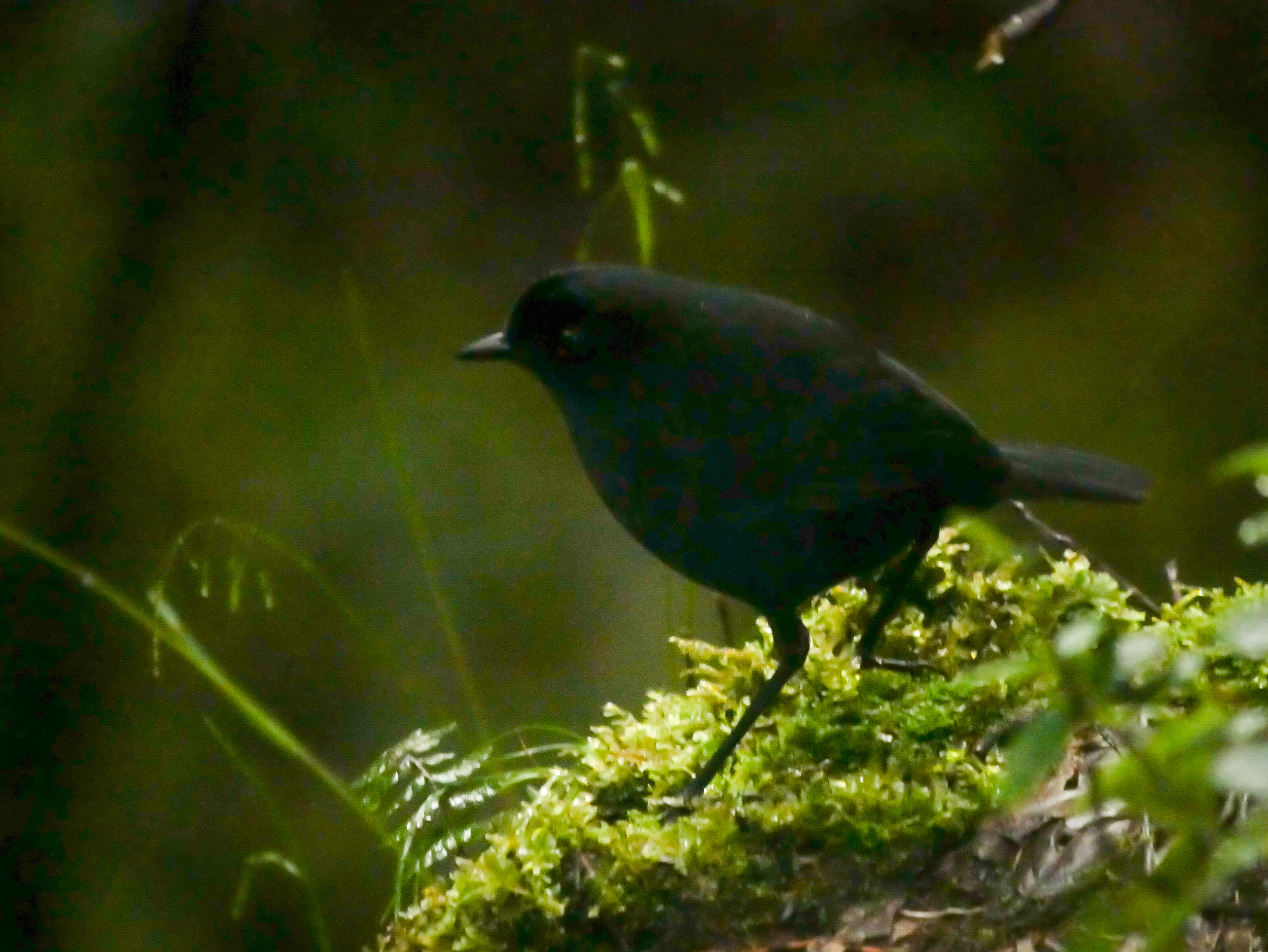
Next, we descend the trail further than we have been previously for our second main target. It gets even steeper and wetter and the trail narrows with steep bushes and large trees either side affording no view. At times it feels like we are walking down a cliff face. Eventually we find a slightly flatter part with moss covered boughs and a stream nearby. Good habitat for Chestnut Forest Rail. We play the call and wait. A few minutes later, we hear it, then again, closer! It’s coming! Then it goes silent. We maintain our guard because this could mean it’s on the move. Suddenly Jon, who is standing facing away from us looking down a narrow gully, without moving a muscle whispers, “I’ve got it”. The stonker is on a log about 5m in front of him in the open. We shape to move cautiously over, but instantly it has gone, flashing across the track. Or at least, that’s what Benny tells me – I see nothing.
It calls again from my side of the trail and appears to be looping around, once more getting close in response to our gently modulated playback. Now incredibly close it is making a pulsing croak. Steve and I peer into the tangle of roots and branches covered in moss fully expecting it will pop up for a second or so a mere 2m in front of us. That is all we need. We make no sound and no movement. Yet unaccountably, suddenly there is a sharp noise, I see a shape flit across a sunlit window and then it calls, now from much further away. We have missed it.
Over the next few hours we try again and hear it two or three times more – we can’t tell if it’s the same or a different bird, but whichever is true, we get no more strong interest and eventually the weather closes in. We could conceivably try again tomorrow, but we both know that we probably won’t have time to walk the trail again, or even want to. This is probably our first major dip. We do have one more new bird – as we prepare to walk back up the trail a different looking bird appears in a fruiting tree. We grill it and get a few record shots, enough for us to conclude this is a female Crested Satinbird.
In the afternoon we once again bird along the road. More relaxing but nothing new, though we do find family of Snow Mountain Quail bringing to 7 the number we have seen. Rather than flying they scuttle off into the roadside scrub. Benny and I follow on foot and I find a couple still quite close. They give great views but are never in the open for the photo I crave. Amazingly two flush from behind Benny – he has walked right past them.
We finish the day by at eth start of the Ibele Trail again. I have persuaded Jon and Steve to come looking for Archbold’s Nightjar. We hear a Spotless Crake which would be a lifer for both Jon and Steve (I see them regularly at a few of my local wetlands near Adelaide) but it’s now dark, and I can’t coax it closer to a point we could get it in my torch. We fail to find the nightjar and knock it on the head. We have one more cold, hard, uncomfortable night to endure before some respite in a hotel tomorrow night!

Day 5, 16/7/18, “In which your intrepid team discover the joys of alcohol-free beer in Wamena…”
As intimated yesterday, a more dedicated team would have been down the trail again, flogging their minds and bodies one more time in the hope of a cute little orange thingy. But we are soft, have a few extra minutes in bed, and then help break camp. For the first time since we have been here the mountains opposite peek out from the clouds and we see the roof of Australasia. Snow Mountain Robin lives up there, but we will not go for it (nor do most).
While Shita, Benny and the locals pack stuff into the vehicles, we bird the road again, finding Short-bearded Melidectes and a female Splendid Astrapia. The Hilux arrives and we bid goodbye to Lake Habema. We spend the rest of the morning and until mid-afternoon birding the road on the way back to Wamena, targetting a few species that are found a little bit lower than our camp. I had thought that the roadside birding would be a welcome relief from the slog of the trail, but the forest here is badly degraded by logging, makeshift camps dot the road, and the depressing sound of chainsaws is an almost constant companion. We stop whenever there is slightly better forest away from a camp.

Our first such stop is quite birdy. Several Snow Mountain Tiger Parrots are vocal above us and we find a couple of MacGregor’s Honeyeater, and a very confiding Splendid Astrapia. Black Sitella is a target this morning and after a couple of fly-overs eventually a flock of 5-6 settles in the top of a tree, distant but affording decent scope views. Plum-faced and Orange-billed Lorikeets give us our best views of the week, and we also find White-winged Robin and Sooty Honeyeater.
From 10am the weather starts to deteriorate as mist rolls in. Hooded Cuckooshrike responds to our playback by singing once or twice, but never close enough to see in what is now <50m visibility. More cooperative are Alpine Pipit and Papuan Treecreeper both of which pose for photos.
Over lunch we have a surreal encounter – a van passes, stops and then reverses so that an angry man can accost Shita. The three of us tourists ignore this and hope it will pass. Later Shita explains that he has aggressively demanded payment for us birding in the National Park. Shita explains that we have all the necessary permissions and that the Park doesn’t start for another 10km – we are outside. She also points out the tragic irony and deep hypocrisy of berating us for birding in a National Park, when all around we can hear the chainsaws of people destroying the forest. It is not fully resolved by the time he drives off, and Shita will have to visit the administrative offices when we get to Wamena to fix it.
After lunch we descend further and spend more time at the spot we’d observed Superb BoP on the way up. It takes quite some time, but eventually we get decent views again (but still no pics) of the (Greater) Superb Bird of Paradise. We also find Ornate Melidectes and Black-breasted Mannikin. Everywhere in New Guinea is owned by someone, and just looking at stuff on someone’s land can get the owner irate (Steve and I witnessed this to our major detriment in the Huon Peninsula 10 ears ago). So when some locals ask us what we are doing and if we have permission from the elders, we realise it’s time to leave.
The rooms of our hotel in Wamena – reputedly the best hotel in the town – are adequate, but feel like luxury compared to our basic accommodation of the previous 4 nights. I have my first shower in nearly a week, ping a few messages off now that I have some phone/data signal, and then find a spot down by the restaurant for a quiet beer with the lads. At least, that last part has been looming large in the imagination until we discover that the whole of Wamena is dry, and the hotel can’t even get anything on the black market for us. Reception tell us they can get non-alcoholic beer. We decide its worth the risk and order two each. Sadly, though the product has the right container and colour, and a vague fizz to it, that is pretty-much where the resemblance to beer stops.
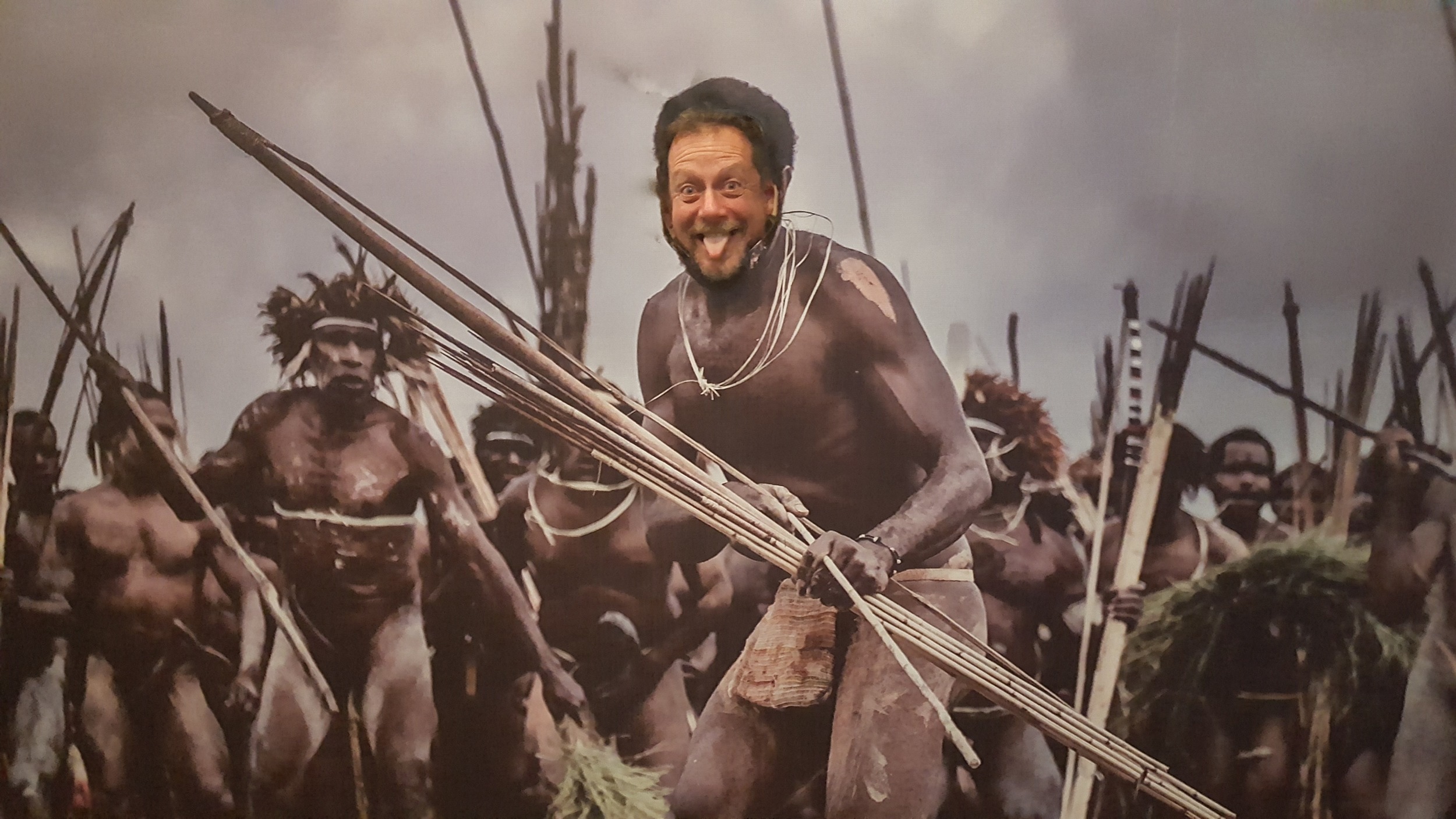
Shita treats us to a fantastic meal of crayfish, the local delicacy caught up in Lake Habema! Tomorrow we will fly back to the hot, sticky lowlands. We will be staying near Nimbokrang, about two hours drive from Sentani, and all being well, we will arrive there just in time to say hello and goodbye to the Birdtour Asia crew who are about to replace us up in the mountains. It will be good to catch up with Rob Hutchinson who is leading the group, even if only for a few minutes.


